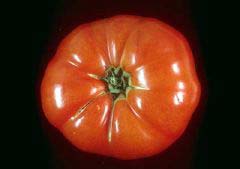Gene Gives Plants a Unique Defense against Disease

Researchers have put a new face on what may be an old genetic weapon to help plants fight off a pesky infection. Abhaya Dandekar and colleagues at the University of California at Davis gave plants an extra gene that protected them from crown gall disease—a scourge of the walnut, grape and rose, among others—when tested in the lab. They publish their findings today in the Proceedings of the National Academy of Sciences.
When the bacterium that causes crown gall disease enters a plant, it starts producing two proteins that help the bug multiply—a phenomenon that leads to cancer in the host. In order to give plants a fighting chance, the researchers engineered strains of the thale cress and the Moneymaker breed of tomato to produce RNA molecules that would inhibit the disease-causing genes. (The tomato pictured here did not come from a plant engineered in this experiment.) Almost all of the transformed plants remained tumor-free after infection with their bacterial foe. This so-called gene-silencing approach, in which one RNA molecule zippers onto a target RNA and shuts it down before it can become a protein, may in fact be an ancient plant defense against certain viruses, Dandekar says. “This whole area is going to provide new ways to combat plant disease,” he predicts.
The crown gall bacterium should find it difficult to rapidly evolve a way around the silencers, the team reports, because the tumor-causing genes are very similar in different strains and would have to change drastically to become resistant. There is also little chance of the resistance genes spreading, Dandekar explains, because the roots and tops of crop plants are typically fused together from different strains, with the roots containing any genetic alterations. The plants could still spread the bacterium, though, the authors note. And like all genetic approaches, Dandekar adds, this one cannot help a field already infested with the disease
Media Contact
All latest news from the category: Life Sciences and Chemistry
Articles and reports from the Life Sciences and chemistry area deal with applied and basic research into modern biology, chemistry and human medicine.
Valuable information can be found on a range of life sciences fields including bacteriology, biochemistry, bionics, bioinformatics, biophysics, biotechnology, genetics, geobotany, human biology, marine biology, microbiology, molecular biology, cellular biology, zoology, bioinorganic chemistry, microchemistry and environmental chemistry.
Newest articles

Sea slugs inspire highly stretchable biomedical sensor
USC Viterbi School of Engineering researcher Hangbo Zhao presents findings on highly stretchable and customizable microneedles for application in fields including neuroscience, tissue engineering, and wearable bioelectronics. The revolution in…

Twisting and binding matter waves with photons in a cavity
Precisely measuring the energy states of individual atoms has been a historical challenge for physicists due to atomic recoil. When an atom interacts with a photon, the atom “recoils” in…

Nanotubes, nanoparticles, and antibodies detect tiny amounts of fentanyl
New sensor is six orders of magnitude more sensitive than the next best thing. A research team at Pitt led by Alexander Star, a chemistry professor in the Kenneth P. Dietrich…





















